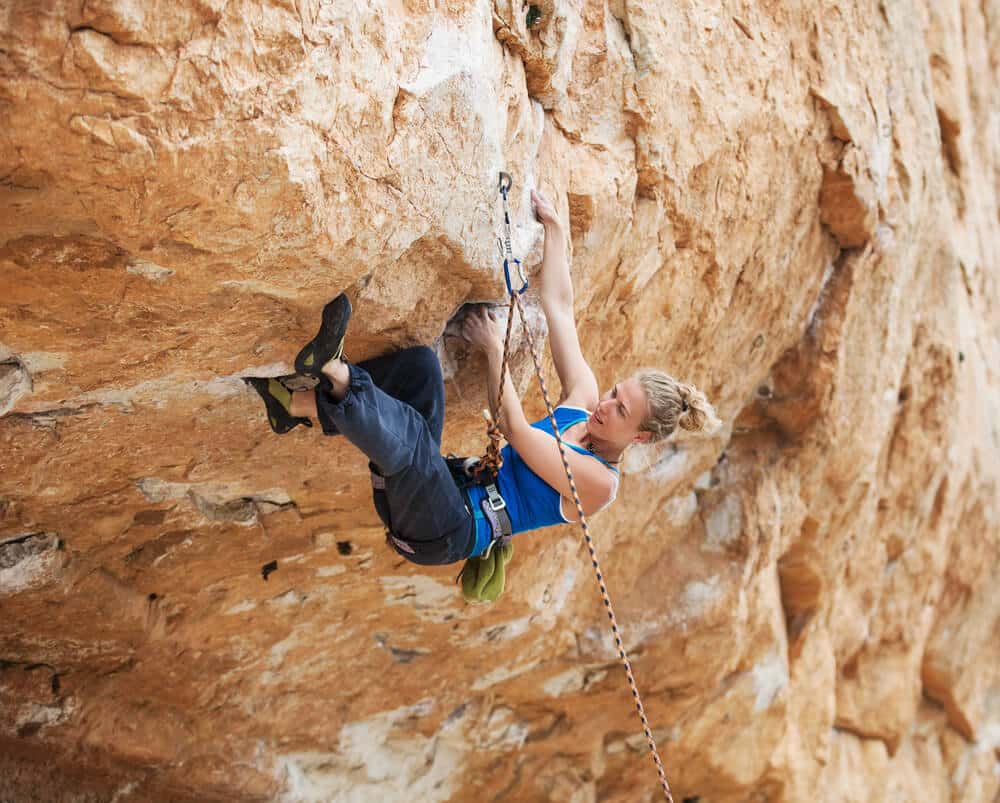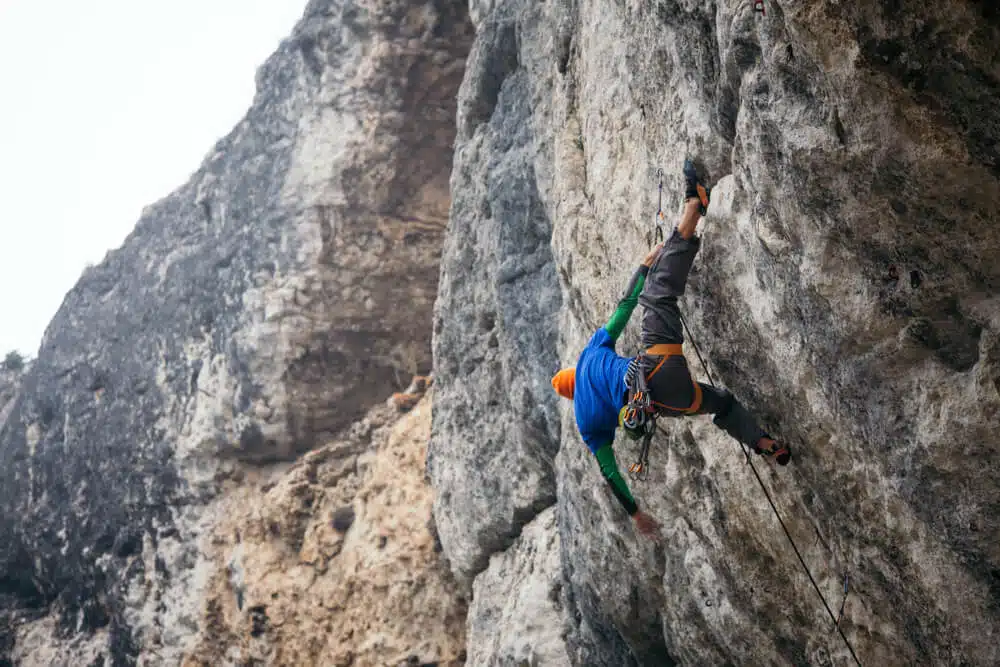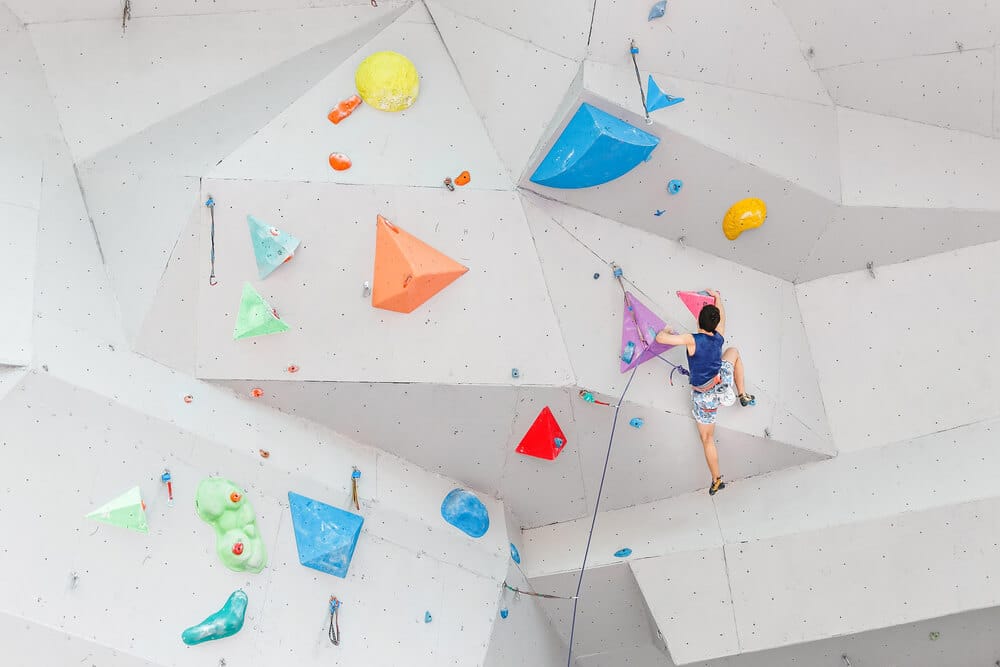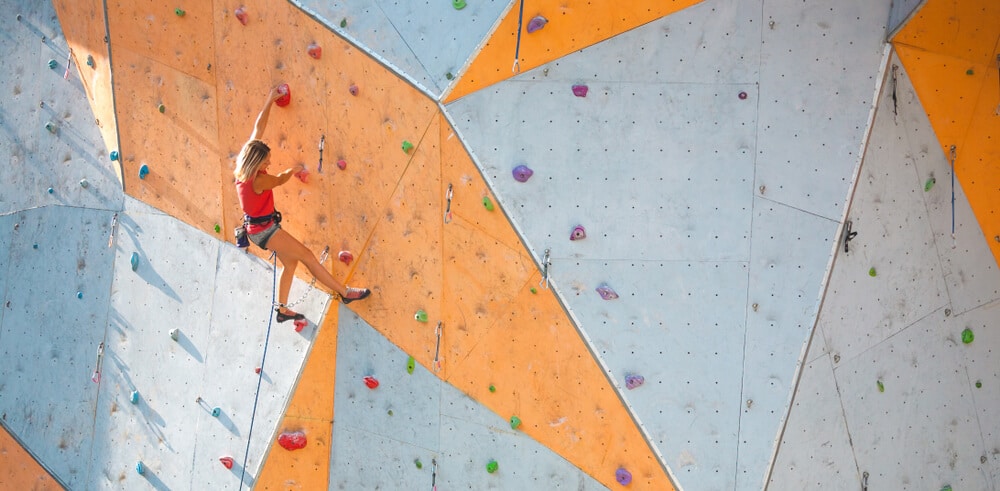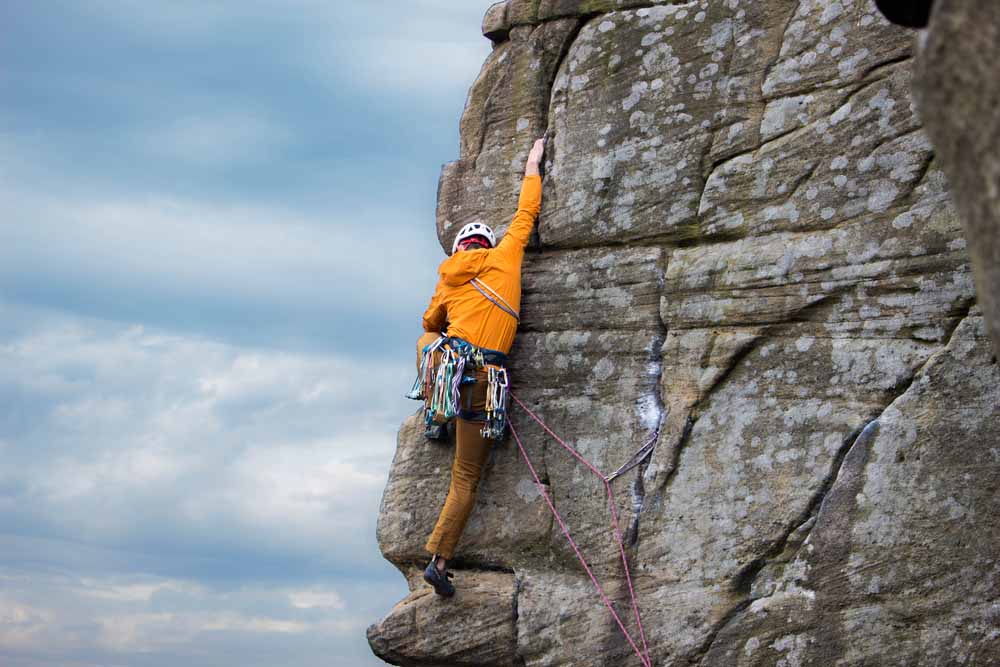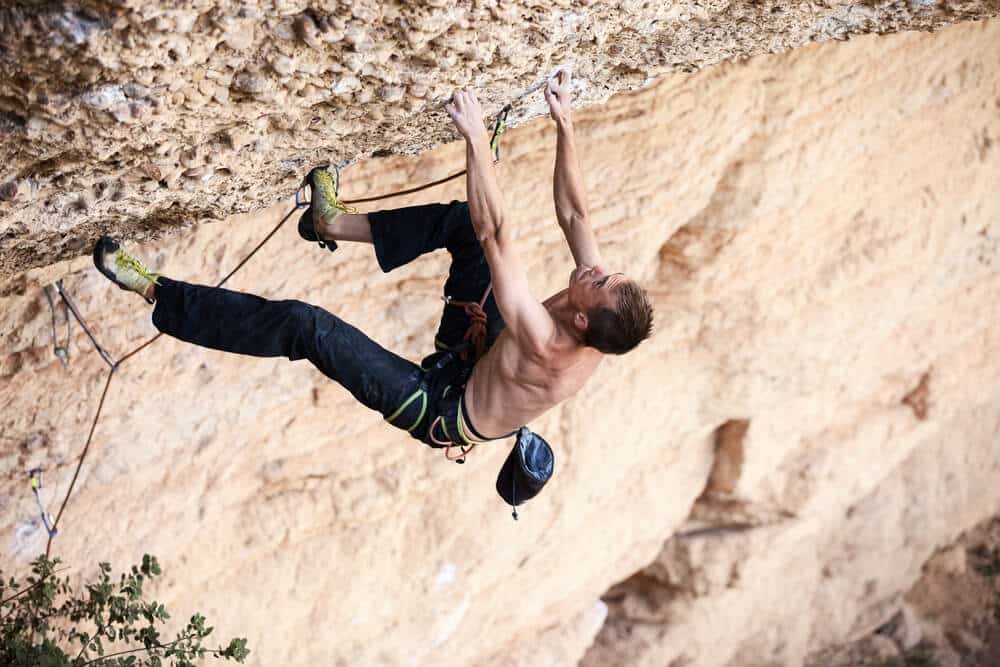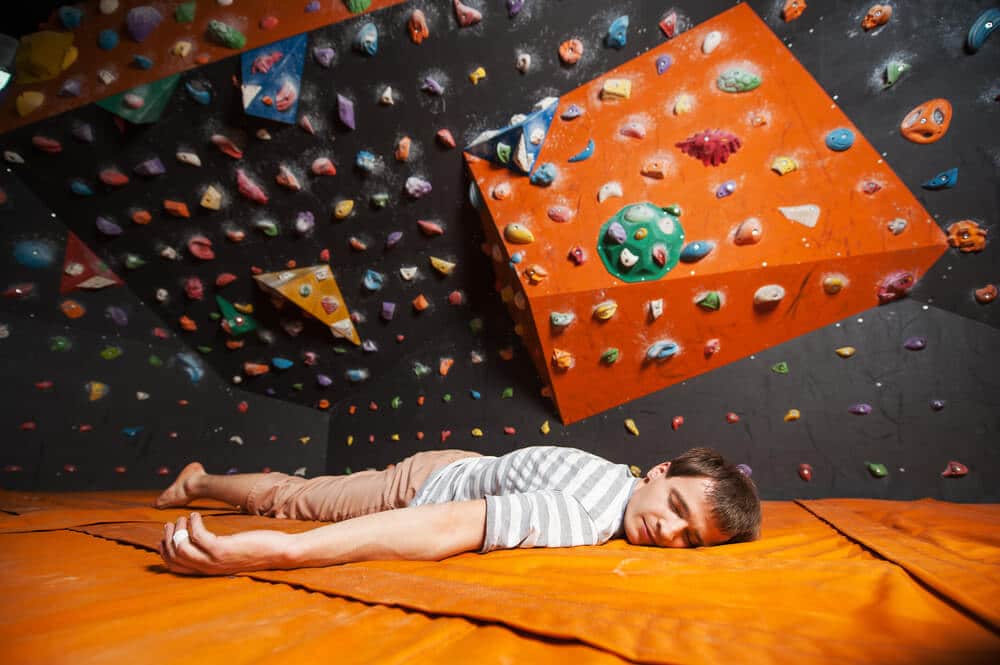If you’re here, you’re wondering how many calories rock climbing burns, how various disciplines break down when it comes to calories burnt, and perhaps whether climbing is an effective tool for weight loss. We’ll dive into all of that in this article. Let’s start with the most basic question…
Does Rock Climbing Burn Calories?
You probably already knew this, but the answer is yes, rock climbing burns calories. Your body burns calories constantly, even when you’re doing absolutely nothing. Mentally demanding activities like playing chess or video games can also increase energy expenditure (usually around 125 calories per hour on the upper end).
Rock climbing, meanwhile, is an intense full-body workout. So just like swimming, running, playing basketball, or lifting weights, it burns a significant amount of calories. For a more detailed look at how many calories rock climbing burns, we have to work through the various disciplines.
What Determines How Many Calories Rock Climbing Burns?
Unfortunately, there are dozens of variables that will determine how many calories you burn while climbing. Personal factors that determine calories burned include age, gender, height, weight, body composition, climbing technique and skill (efficiency), and cardiovascular health.
Other factors could be situational, like your familiarity with the route, terrain, and style of climbing, the altitude, the temperature, and the gradient (roof vs. slab, for example).
For example, let’s say you’re an extremely strong boulderer and sport climber but don’t know anything about trad climbing. You’ll likely be very energy efficient while climbing in the former two disciplines, but will expend a significant amount of energy even on a relatively mellow trad climb due to the added stress of placing gear, building anchors, and other concepts you’re unfamiliar with.
Calories Burnt in a Single Climbing Session
As we just explained, everyone burns calories differently. But on a broad spectrum, Nutrition for Climbers indicates that the average climber burns around 10 calories per minute of climbing. That’s 600 calories per hour, though it’s rare that someone is actively climbing for an hour. Usually you’ll be taking a few hard burns, then belaying or resting, even if you’re on a big wall.
How do they reach this number? Via a measurement called Metabolic Equivalents (METs). One MET of energy expenditure is equal to 1 calorie per kilogram per hour of activity.
General rock climbing is 8 METS, so for a climber of around 160 pounds (73 kg), you’d take 73 x 8 x 1 hour, and you’d come out with 584 calories burned in an hour-long climbing session.
With this information in mind, you can see that it’s basically impossible to pinpoint an exact amount of calories burnt in a given scenario. 600 calories per hour is a good number for an average weight (160 lbs), but some climbers report as low as 400 or as high as 900. Age, gender, experience, and those other factors mentioned above make it very hard to get more specific than that.
That said, let’s try to think about what we know about the most common climbing disciplines and estimate how a climbing session would burn calories comparatively.
Bouldering
Bouldering is high-intensity but low duration. You’ll burn a lot of calories for the few minutes you’re on the problem, then less while relaxing or spotting another climber in between your own attempts. The harder the problem and the more time you spend on it during your session, the more calories you’ll burn.
Sport Climbing
Like bouldering, sport climbing sessions are typically shorter, although you’ll be on the wall and burning calories, for longer than you will on a boulder. Again though, we have to look at the relationship between difficulty and duration. Spending 20 minutes hiking an easy bolted route and 5 minutes on an extremely difficult boulder will probably burn around the same amount of calories.
Traditional Climbing
Hard traditional climbing is probably the most holistic exercise in rock climbing because it involves a high level of technique, fitness, and skill both in gear placement and body placement, with an increased focus on stamina.
Again, difficulty and duration determine the outcome of calories burned, but if you’re looking at 10 minutes of trad climbing on a 5.8 versus 10 minutes of sport climbing on a 5.8, the traditional route will probably burn more calories for the average climber.
Multi-Pitch and Big Wall Climbing
These disciplines are also going to burn a lot of calories, because you’re on the wall for a long period of time. Even when you’re belaying or resting, you’re in awkward positions, facing the elements, and dealing with sometimes complex rigging and rope systems.
Before you get all stoked and run out to buy a portaledge though, let’s talk about climbing and weight loss, because a hyperfocus on weight loss is neither healthy nor the best way to become a better climber.
Is Rock Climbing an Effective Way to Lose Weight?
Losing weight requires hitting a calorie deficit. That means consuming fewer calories than you burn. There are probably faster ways to burn calories than climbing, chiefly aerobic activities such as running and swimming.
Running burns around 100 calories per mile, so as long as you’re running under a 10-minute mile, you’re burning more calories (on average) running than you are climbing.
But asking, “Is rock climbing an effective way to burn calories?” is probably the wrong question. All physical activities burn calories.
The question is, “Do you enjoy climbing?”
If you are on a weight loss journey, then any physical activity that you enjoy will certainly help. The more direct way to lose weight isn’t to exercise 24/7 but to ensure you’re hitting a calorie deficit, eating and drinking fewer calories than your body burns.
Will Losing Weight Make You a Better Climber?
This is a trademark question in our sport. Climbing performance is often associated with being as light as possible. It makes sense, because climbing is focused around pulling and pushing yourself upward, and the less weight you’re carrying, the easier it is to move upward. At first glance, it can seem like hiking up a mountain. The lighter your pack, the easier it is to get to the summit.
Yes, the best climbers are quite thin, with extremely low body fat and a high muscle-to-mass ratio. Adam Ondra is the perfect example. This is part of the reason why it’s easy for many professionals (think Ashima Shiraishi) to be climbing phenoms at an extremely young age. Everyone has watched a skinny, all bones-and-sinew kid flash their project in the gym.
But ultimately, if you want to become a better climber, the focus should be on becoming stronger, not lighter. That backpack analogy isn’t really doesn’t make sense when you examine it closer. Your body is the backpack. It’s not just what you’re carrying; it’s what you’re using to carry it. You need muscle and energy to move yourself, too.
Climbing requires you to be strong and full of energy, and for that… well, you need lots of calories!
If your Body Mass Index (BMI: weight in kg divided by the square of height in meters) is 30 or greater, then you are considered obese per the CDC. In that case, losing some weight will improve your overall health, life expectancy, and surely your climbing performance along the way. But this isn’t a hard and fast rule. Everybody is different, and there are plenty of healthy, happy climbers who would be considered overweight per BMI.
More importantly, for the average healthy climber, weight loss can quickly lead down the wrong path. Losing weight puts you at risk for a variety of health issues, including disordered eating (check out this great film, LIGHT, on the subject), as well as recovery and training difficulties. If your BMI is less than 18.5, then you’re classified as underweight, and that can be just as detrimental to your physical health as being overweight.
Weight loss has been particularly associated with a disorder called Relative Energy Deficiency in Sport (RED-S), which essentially means not consuming enough calories to match your energy expenditure. The phenomenon has become such a major issue that the International Federation of Sport Climbing (IFSC) recently released a statement about the extensive actions they’re undergoing to reduce RED-S instances in 2024.
Conclusion
Like many physical activities, rock climbing is a good way to burn calories and stay healthy. If you’re curious about how many calories you’ll burn while climbing, take about 600 calories an hour as a good starting rate.
That said, you shouldn’t focus on burning calories or losing weight to become a better climber, unless you’re already overweight and at risk for health issues as a result. Research doesn’t back weight loss up as a determining factor in climbing performance, and it could cause health problems down the line.
Instead, focus on developing your strength, flexibility, nutrition, and technique. Working on these four principles is the quickest way to climb harder and longer!


